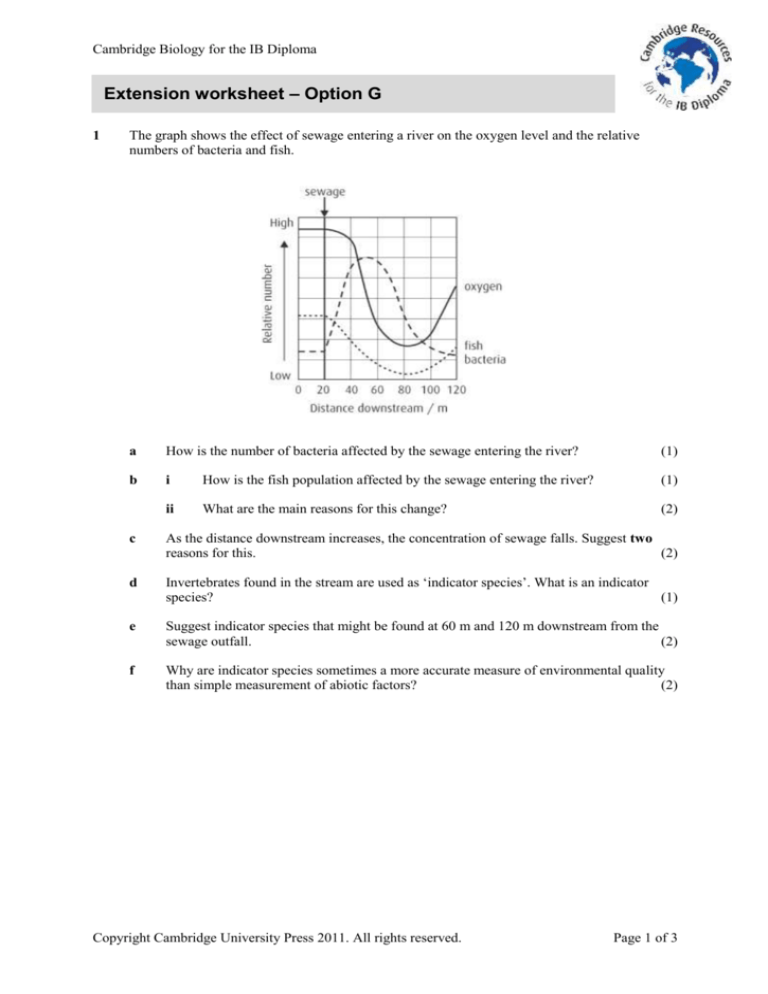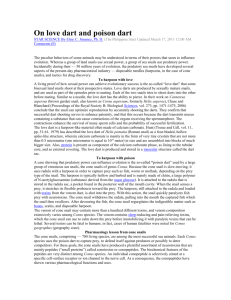
Cambridge Biology for the IB Diploma
Extension worksheet – Option G
1
The graph shows the effect of sewage entering a river on the oxygen level and the relative
numbers of bacteria and fish.
a
How is the number of bacteria affected by the sewage entering the river?
(1)
b
i
How is the fish population affected by the sewage entering the river?
(1)
ii
What are the main reasons for this change?
(2)
c
As the distance downstream increases, the concentration of sewage falls. Suggest two
reasons for this.
(2)
d
Invertebrates found in the stream are used as ‘indicator species’. What is an indicator
species?
(1)
e
Suggest indicator species that might be found at 60 m and 120 m downstream from the
sewage outfall.
(2)
f
Why are indicator species sometimes a more accurate measure of environmental quality
than simple measurement of abiotic factors?
(2)
Copyright Cambridge University Press 2011. All rights reserved.
Page 1 of 3
Cambridge Biology for the IB Diploma
2
a
Introduced alien species can cause damage to native plants or crops. The graph
shows how the population of introduced snails, which are a pest in a field
growing crop plants, varied over a number of years.
i
Suggest why the population of the snails changed over period A.
(3)
ii
Was the livelihood of the farmer threatened by the snails at any time? Explain your
answer.
(2)
b
Outline a suitable method that might be used to measure the population of snails.
c
At the start of period B, a biological control species was introduced. Suggest a type of
control species that could be used.
(1)
d
Describe and explain the change in the snail population over period B.
e
Suggest the most likely reason for the pattern of snail numbers over the period of time C.
(1)
f
Discuss the probability that the snail population will be permanently controlled by this
method.
(2)
Copyright Cambridge University Press 2011. All rights reserved.
(2)
(2)
Page 2 of 3
Cambridge Biology for the IB Diploma
3
a
Outline what is meant by the term ‘biodiversity’ in an ecosystem.
(1)
b
Why is it important to maintain biodiversity in a rainforest?
(2)
c
A survey was carried out to compare the invertebrates found in an area of rainforest and
a deciduous woodland. The data are shown in the table below.
Number of invertebrates found (n)
Species
Rainforest site
A
3
6
B
0
3
C
20
8
D
18
2
E
7
2
F
8
3
G
19
4
H
9
4
I
10
2
J
5
7
K
15
3
L
9
5
123
Total (N)
Simpson index D
i
9.30
Calculate the Simpson index, D, for the deciduous woodland.
D
d
Deciduous
woodland site
(2)
N ( N 1)
n(n 1)
ii
What differences are there in the biodiversity of the two sites?
(2)
iii
Suggest possible reasons for the differences observed.
(2)
It has been suggested that global warming may accelerate the loss of biodiversity. Give
two reasons why this may be the case.
(2)
Copyright Cambridge University Press 2011. All rights reserved.
Page 3 of 3







